Mineralogy and Distribution of Critical Elements in the Sn–W–Pb–Ag–Zn Huanuni Deposit, Bolivia
Abstract
1. Introduction
2. Geology
3. Methodology
4. Mineralogy
4.1. Alteration and Gangue Minerals
4.2. Ore Minerals
4.3. Petrography
4.4. Paragenetic Sequences
5. Mineral Chemistry
6. Sulphur Isotopes
7. Discussion
7.1. Paragenetic Constraints on the Genesis of the Deposit
7.2. Mineralogy and Distribution of Critical Elements
7.3. Sources for Sulphur
8. Conclusions
Supplementary Materials
Author Contributions
Funding
Acknowledgments
Conflicts of Interest
References
- Turneaure, F.S. The Bolivian tin–silver province. Econ. Geol. 1971, 66, 215–225. [Google Scholar] [CrossRef]
- Lehmann, B.; Ishihara, S.; Michel, H.; Miller, J.; Rapela, C.; Sanchez, A.; Tistl, M.; Winkelmann, L. The Bolivian tin province and regional tin distribution in the central Andes: A reassessment. Econ. Geol. 1990, 85, 1044–1058. [Google Scholar] [CrossRef]
- Mlynarczyk, M.S.J.; Williams-Jones, A.E. The role of collisional tectonics in the metallogeny of the Central Andean tin belt. Earth Planet. Sci. Lett. 2005, 240, 656–667. [Google Scholar] [CrossRef]
- Ishihara, S.; Murakami, H.; Marquez-Zavalia, M.F. Inferred indium resources of the Bolivian tin-polymetallic deposits. Resour. Geol. 2011, 61, 174–191. [Google Scholar] [CrossRef]
- Jiménez-Franco, A.; Alfonso, P.; Canet, C.; Trujillo, J.E. Mineral chemistry of In-bearing minerals in the Santa Fe mining district, Bolivia. Andean Geol. 2018, 45, 410–432. [Google Scholar] [CrossRef]
- Murakami, H.; Ishihara, S. Trace elements of indium-bearing sphalerite from tin-polymetallic deposits in Bolivia, China and Japan: A femto-second LA-ICPMS study. Ore Geol. Rev. 2013, 53, 223–243. [Google Scholar] [CrossRef]
- Schwarz-Schampera, U.; Herzig, P.M. Indium: Geology, Mineralogy and Economics; Springer: Heidelberg, Germany, 2002. [Google Scholar]
- Torró, L.; Cazorla, M.; Melgarejo, J.C.; Camprubí, A.; Tarrés, M.; Gemmrich, L.; Campeny, M.; Castillo-Oliver, M.; Artiaga, D.; Torres, B.; et al. Indium mineralization in the volcanic dome-hosted Ánimas–Chocaya–Siete Suyos polymetallic deposit, Potosí, Bolivia. Minerals 2019, 9, 604. [Google Scholar] [CrossRef]
- Torró, L.; Melgarejo, J.C.; Gemmrich, L.; Mollinedo, D.; Cazorla, M.; Martínez, Á.; Pujol-Solà, N.; Farré de Pablo, J.; Camprubí, A.; Artiaga, D.; et al. Spatial and temporal controls on the distribution of indium in xenothermal vein deposits: The Huari Huari district, Potosí, Bolivia. Minerals 2019, 9, 304. [Google Scholar] [CrossRef]
- Torres, B.; Melgarejo, J.C.; Torró, L.; Camprubí, A.; Castillo-Oliver, M.; Artiaga, D.; Campeny, M.; Tauler, E.; Jiménez-Franco, A.; Alfonso, P.; et al. The Poopó Polymetallic Epithermal Deposit, Bolivia: Mineralogy, Genetic Constraints, and Distribution of Critical Elements. Minerals 2019, 9, 472. [Google Scholar] [CrossRef]
- European Commission, Critical Raw Materials. Available online: https://ec.europa.eu/growth/sectors/raw-materials/specific-interest/critical_en (accessed on 1 April 2019).
- Turneaure, F.S. A comparative study of major ore deposits of central Bolivia. Part, I. Econ. Geol. 1960, 55, 217–254. [Google Scholar] [CrossRef]
- Turneaure, F.S. A comparative study of major ore deposits of central Bolivia. Part II. Econ. Geol. 1960, 55, 574–606. [Google Scholar] [CrossRef]
- Kelly, W.C.; Turneaure, F.S. Mineralogy, paragenesis, and geothermometry of the tin and tungsten deposits of the eastern Andes, Bolivia. Econ. Geol. 1970, 65, 609–680. [Google Scholar] [CrossRef]
- Sugaki, A.; Kojima, S.; Shimada, N. Fluid inclusion studies of the polymetallic hydrothermal ore deposits in Bolivia. Miner. Deposita 1988, 23, 9–15. [Google Scholar] [CrossRef]
- Arce, O.; Nambu, M. Fluid inclusion study in the Huanuni mine, Bolivia. J. Min. Mater. Process. Inst. Jpn. 1989, 105, 1073–1078. [Google Scholar] [CrossRef]
- Müller, B.; Frischknecht, R.; Seward, T.; Heinrich, C.; Camargo Gallegos, W. A fluid inclusion reconnaissance study of the Huanuni tin deposit (Bolivia), using LA-ICP-MS micro-analysis. Miner. Depos. 2001, 36, 680–688. [Google Scholar] [CrossRef]
- Ahlfeld, F.; Schneider-Scherbina, A. Los yacimientos minerales y de hidrocarburos de Bolivia. Bol. Dept. Nac. Geol. La Paz 1964, 5, 388. [Google Scholar]
- Lehmann, B. Metallogeny of Tin: Springer-Verlag (Lecture Notes in Earth Sciences Series, 31); Springer: Berlin/Heidelberg, Germany, 1990; p. 211. [Google Scholar]
- Redwood, S. The Metallogeny of the Bolivian Andes. Vancouver, British Columbia, University of British Columbia; Mineral Deposit Research Unit 15: Ottawa, ON, Canada, 1993; p. 59. [Google Scholar]
- Heuschmidt, B.; Bellot de la Torre, J.; Miranda Angles, V.; Claure Zapata, M. Las Areas Prospectivas de Bolivia para yacimientos metalíferos. Boletín del Servicio Nacional de Geología y Minería 2002, 30, 1–154. [Google Scholar]
- Suarez-Soruco, R. Compendio de Geología de Bolivia; Servicio Nacional de Geología y Minería, Yacimientos Petrolíferos Fiscales Bolivianos: Cochabamba, Bolivia, 2000; pp. 39–76. [Google Scholar]
- McQuarrie, N.; DeCelles, P.G. Geometry and structural evolution of the Central Andean backthrust belt, Bolivia. Tectonics 2001, 20, 669–692. [Google Scholar] [CrossRef]
- Redwood, S.D.; Rice, C.M. Petrogenesis of Miocene basic shoshonitic lavas in the Bolivian Andes and implications for hydrothermal gold, silver and tin deposits. J. South. Am. Earth Sci. 1997, 10, 203–221. [Google Scholar] [CrossRef]
- Morgan VI, G.B.; London, D.; Luedke, R.G. Petrochemistry of Late Miocene peraluminous silicic volcanic rocks from the Morococala field, Bolivia. J. Petrol. 1998, 39, 601–632. [Google Scholar] [CrossRef]
- De Silva, S.; Kay, S.M. Turning up the heat: High-flux magmatism in the Central Andes. Elements 2018, 9, 245–250. [Google Scholar] [CrossRef]
- Wörner, G.; Mamani, M.; Blum-Oeste, M. Magmatism in the Central Andes. Elements 2018, 9, 237–244. [Google Scholar] [CrossRef]
- Koeppen, R.P.; Smith, R.L.; Kunk, M.J.; Flores, A.M.; Luedke, R.G.; Sutter, J.F. The Morococala volcanics: Highly peraluminous rhyolite ash flow magmatism in the Cordillera Oriental, Bolivia. Geol. Soc. Am. Abstr. Programs 1987, 19, 731. [Google Scholar]
- Benedetto, J.L.; Sánchez, T.M.; Brusa, E.D. Las cuencas silúricas de América Latina. In Paleozoico Inferior de Ibero-América; Gutiérrez, J.G., Saavedra, M.J., Rábano, I., Eds.; Universidad de Extremadura: Badajoz, Spain, 1992; pp. 119–148. [Google Scholar]
- Sempere, T. Phanerozoic evolution of Bolivia and adjacent regions. In Petroleμm Basins of South America; Tankard, A.J., Suárez, R., Welsink, H.J., Eds.; AAPG Mem: Tulsa, OK, USA, 1995; pp. 207–230. [Google Scholar]
- Arce-Burgoa, O. Guía de los Yacimientos metalíferos de Bolivia; Minera San Cristóbal, S.A., Ed.; SPC Impresiones S.A.: La Paz, Bolivia, 2009; pp. 4–12. [Google Scholar]
- Cacho, A.; Melgarejo, J.C.; Torró, L.; Arqués, L.; Martínez, Á.; Torres, B.; Artiaga, D.; Tauler, E.; Condori, R.; Guevara, N.; et al. Huanuni, Bonanza and La Suerte mines: Mineralogy, geochemistry and structure. In Mineral Resources in A Sustainable World, 13th SGA Biennial Meeting 2015; André-Meyer, A.-S., Cathelineau, M., Muchez, P., Pirard, E., Sindern, S., Eds.; Proceedings: Nancy, France, 2015; pp. 691–694. [Google Scholar]
- Jochum, K.P.; Weis, U.; Stoll, B.; Kuzmin, D.; Yang, Q.; Raczek, I.; Jacob, D.E.; Stracke, A.; Birbaum, K.; Frick, D.A.; et al. Determination of reference values for NIST SRM 610-617 glasses following ISO guidelines. Geostand. Geoanal. Res. 2011, 35, 397–429. [Google Scholar] [CrossRef]
- Van Achterbergh, E.; Ryan, C.G.; Jackson, S.E.; Griffin, W.L. Data reduction software for LA-ICP-MS: Appendix. In Laser Ablation–ICP–Mass Spectrometry in the EARTH Sciences: Principles and Applications. The Mineralogical Association of Canada Short Course Series; Sylvester, P.J., Ed.; Mineralogical Association of Canada, St. Johns: Quebec, QC, Canada, 2001; pp. 239–243. [Google Scholar]
- Griffin, W.L.; Powell, W.J.; Pearson, N.; O’Reilly, S.Y. GLITTER: Data reduction software for laser ablation ICP-MS. In Laser Ablation–ICP–MS in the Earth Sciences. Mineralogical Association of Canada Short Course Series; Sylvester, P.J., Ed.; Mineralogical Association of Canada, St. Johns: Quebec, QC, Canada, 2008; pp. 204–207. [Google Scholar]
- Baker, T.; Mustard, R.; Brown, V.; Pearson, N.; Stanley, C.R.; Radford, N.W.; Butler, I. Textural and chemical zonation of pyrite at Pajingo: A potential vector to epithermal gold veins. Geochem Explor. Environ. Anal. 2004, 6, 283–293. [Google Scholar] [CrossRef]
- Wilson, S.A.; Ridley, W.I.; Koenig, A.E. Development of sulfide calibration standards for the laser ablation inductively-coupled plasma mass spectrometry technique. J. Anal. At. Spectrom. 2002, 17, 406–409. [Google Scholar] [CrossRef]
- Santivañez, R. Mineralogía y termometría de las vetas Keller (Huanuni). Memoria del Coloquio del IGE. Conv. UMSA-JICA 1986, 2, 131–157. [Google Scholar]
- Mindat.org, Huanuni, Dalence Province, Oruro, Bolivia. Available online: https://www.mindat.org/loc-14512.html (accessed on 28 February 2019).
- Anthony, J.W.; Bideaux, R.A.; Bladh, K.W.; Nichols, M.C. Handbook of Mineralogy, Volume IV; Arsenates, Phosphates, Vanadates; Mineral Data Publishing: Tucson, AZ, USA, 2000; p. 680. [Google Scholar]
- Grant, J.N.; Halls, C.; Avila, W.; Avila, G. Igneous geology and the evolution of hydrothermal systems in some sub-volcanic tin deposits of Bolivia. Geol. Lond. Soc. Spec. Publ. 1977, 7, 117–126. [Google Scholar] [CrossRef]
- Krienitz, M.-S.; Trumbull, R.B.; Hellmann, A.; Kolb, J.; Meyer, F.M.; Wiedenbeck, M. Hydrothermal gold mineralization at the Hira Buddini gold mine, India: Constraints on fluid evolution and fluid sources from boron isotopic compositions of tourmaline. Miner. Deposita 2008, 43, 421–434. [Google Scholar] [CrossRef]
- Baksheev, I.A.; Tikhomirov, P.L.; Yapaskurt, V.O.; Vigasina, M.F.; Prokof’ev, V.Y.; Ustinov, V.I. Tourmaline of the Mramorny tin cluster, Chukotka peninsula, Russia. Can. Mineral. 2009, 47, 1177–1194. [Google Scholar] [CrossRef]
- Prokofiev, V.; Baksheev, I.; Zorina, L.; Belyatsky, B.; Ustinov, V.; Krivitskaya, N. Tourmalinization at the Darasun goldfield, Eastern Transbaikalia: Compositional, fluid inclusion and isotopic constraints. Geosci. Front. 2012, 3, 59–71. [Google Scholar] [CrossRef][Green Version]
- Marks, M.A.W.; Marschall, H.R.; Schühle, P.; Guth, A.; Wenzel, T.; Jacob, D.E.; Barth, M.; Markl, G. Trace element systematics of tourmaline in pegmatitic and hydrothermal systems from the Variscan Schwarzwald (Germany): The importance of major element composition, sector zoning, and fluid or melt composition. Chem. Geol. 2013, 344, 73–90. [Google Scholar] [CrossRef]
- Huang, S.; Song, Y.; Hou, Z.; Xue, C. Chemical and stable isotopic (B, H, and O) compositions of tourmaline in the Maocaoping vein-type Cu deposit, western Yunnan, China: Constraints on fluid source and evolution. Chem. Geol. 2016, 439, 173–188. [Google Scholar] [CrossRef]
- Hedenquist, J.W.; Arribas, A.; Jr Reynolds, T.J. Evolution of an intrusive-centered hydrothermal system: Far Southwest-Lepanto porphyry and epithermal Cu-Au deposits, Philippines. Econ. Geol. 1998, 93, 373–404. [Google Scholar] [CrossRef]
- Milu, V.; Milési, J.-P.; Leroy, J.L. Rosia Poieni copper deposit, Apuseni Mountains, Romania: Advanced argillic overprint of a porphyry system. Min. Deposita 2004, 39, 173–188. [Google Scholar] [CrossRef]
- Longo, A.A.; Dilles, J.H.; Grunder, A.L.; Duncan, R. Evolution of calc-alkaline volcanism and associated hydrothermal gold deposits at Yanacocha, Peru. Econ. Geol. 2010, 105, 1191–1241. [Google Scholar] [CrossRef]
- Sugaki, A.; Ueno, H.; Shimada, N.; Kitakaze, A.; Hayashi, K.; Shima, H.; Sanjines, O.; Saavedra, A. Geological Study on Polymetallic Hydrothermal Deposits in the Oruro District, Bolivia. Sci. Rep. Tohoku Univ. Ser. III 1981, 15, 1–52. [Google Scholar]
- Hronsky, J.M.A.; Groves, D.I.; Loucks, R.R.; Begg, G.C. A unified model for gold mineralisation in accretionary orogens and implications for regional-scale exploration targeting methods. Miner. Dep. 2012, 47, 339–358. [Google Scholar] [CrossRef]
- McCuaig, T.C.; Hronsky, J.M.A. The mineral system concept: The key to exploration targeting. Soc. Econ. Geol. Spec. Publ. 2014, 18, 153–175. [Google Scholar] [CrossRef]
- Huston, D.L.; Mernagh, T.P.; Hagemann, S.G.; Doublier, M.P.; Fiorentini, M.; Champion, D.C.; Jaques, A.L.; Czarnota, K.; Cayley, R.; Skirrow, R.; et al. Tectono-metallogenic systems—The place of mineral systems within tectonic evolution, with an emphasis on Australian examples. Ore Geol. Rev. 2016, 76, 168–210. [Google Scholar] [CrossRef]
- King, J.; Williams-Jones, A.E.; Van Hinsberg, V.; Williams-Jones, G. High-sulfidation epithermal pyrite-hosted Au (Ag-Cu) ore formation by condensed magmatic vapors on Sangihe Island, Indonesia. Econ. Geol. 2014, 109, 1705–1733. [Google Scholar] [CrossRef]
- Andersen, J.C.Ø.; Stickland, R.J.; Rollinson, G.K.; Shail, R.K. Indium mineralisation in SW England: Host parageneses and mineralogical relations. Ore Geol. Rev. 2016, 78, 213–238. [Google Scholar] [CrossRef]
- Lopez, L.; Jovic, S.M.; Guido, D.M.; Permuy-Vidal, C.; Páez, G.N.; Ruiz, R. Geochemical distribution and supergene behavior of indium at the Pingüino epithermal polymetallic vein system, Patagonia, Argentina. Ore Geol. Rev. 2015, 64, 747–755. [Google Scholar] [CrossRef]
- Werner, A.; Haseneder, R.; Repke, J.-U. pH-dependent retention measurements of indium and germanium with nanofiltration membranes. Freib. Online Geosci. 2015, 40, 136–137. [Google Scholar]
- Liu, Y.; Fan, Y.-Y.; Qi, J.-F.; Tian, L.; Zhang, T.-A. Research on sulfur conversion behavior in oxygen pressure acid leaching process of high indium sphalerite. In Materials Processing Fundamentals 2018. TMS 2018. The Minerals, Metals & Materials Series; Lambotte, G., Lee, J., Allanore, A., Wagstaff, S., Eds.; Springer: Berlin/Heidelberg, Germany, 2018; pp. 199–208. [Google Scholar]
- Sugaki, A.; Ueno, H.; Hayashi, K. Sulfur isotope reconnaissance of Bolivian hydrothermal deposits. Min. Geol. 1990, 40, 299–312. [Google Scholar]
- Xiong, Y.Q.; Shao, Y.J.; Mao, J.W.; Wu, S.C.; Zheng, M.H. The polymetallic magmatic-hydrothermal Xiangdong and Dalong systems in the W–Sn–Cu–Pb–Zn–Ag Dengfuxian orefield, SE China: Constraints from geology, fluid inclusions, H–O–S–Pb isotopes, and sphalerite Rb–Sr geochronology. Miner. Deposita 2019. [Google Scholar] [CrossRef]
- Camprubí, A.; Cardellach, E.; Canals, À.; Lucchini, R. The La Guitarra Ag-Au low sulfidation epithermal deposit, Temascaltepec district, Mexico: Fluid inclusion and stable isotope data. In New mines and discoveries in Mexico and Central America; Albinson, T., Nelson, C.E., Eds.; Society of Economic Geologists Special Publication: Littleton, CO, USA, 2001; pp. 159–185. [Google Scholar]
- Camprubí, A.; González-Partida, E.; Torres-Tafolla, E. Fluid inclusion and stable isotope study of the Cobre–Babilonia polymetallic epithermal vein system, Taxco district, Guerrero, Mexico. J. Geochem. Explor. 2006, 89, 33–38. [Google Scholar] [CrossRef]
- Mango, H.; Arehart, G.; Oreskes, N.; Zantop, H. Origin of epithermal Ag–Au–Cu–Pb–Zn mineralization in Guanajuato, Mexico. Miner. Deposita 2014, 49, 119–143. [Google Scholar] [CrossRef]
- Seal, I.R. Sulfur isotope geochemistry of sulfide minerals. Rev. Mineral. Geochem. 2006, 61, 633–677. [Google Scholar] [CrossRef]
- Ishihara, S. The granitoid series and mineralization. Econ. Geol. 1981, 75, 458–484. [Google Scholar]
- Lehmann, B.; Dietrich, A.; Heinhorst, J.; Metrich, N.; Mosbah, M.; Palacios, C.; Schneider, H.J.; Wallianos, A.; Webster, J.; Winkelmann, L. Boron in the Bolivian tin belt. Mineral. Dep. 2000, 35, 223–232. [Google Scholar] [CrossRef]
- Frikken, P.H.; Cooke, D.R.; Walshe, J.L.; Archibald, D.; Skarmeta, J.; Serrano, L.; Vargas, R. Mineralogical and isotopic zonation in the Sur-Sur tourmaline breccia, Río Blanco-Los Bronces Cu-Mo deposit, Chile: Implications for ore genesis. Econ. Geol. 2005, 100, 935–961. [Google Scholar] [CrossRef]
- Wilson, A.J.; Cooke, D.R.; Harper, B.J.; Deyell, C.L. Sulfur isotopic zonation in the Cadia district, southeastern Australia: Exploration significance and implications for the genesis of alkalic porphyry gold-copper deposits. Mineral. Dep. 2007, 42, 465–487. [Google Scholar] [CrossRef]
- Zukowski, W.; Cooke, D.R.; Deyell, C.L.; McInnes, P.; Simpson, K. Genesis and exploration implications of epithermal gold mineralization and porphyry-style alteration at the Endeavour 41 prospect, Cowal District, New South Wales, Australia. Econ. Geol. 2014, 109, 1079–1115. [Google Scholar] [CrossRef]
- Ireland, T.; Large, R.R.; McGoldrick, P.; Blake, M. Spatial distribution patterns of sulfur isotopes, nodular carbonate, and ore textures in the McArthur River (HYC) Zn-Pb-Ag deposit, Northern Territory, Australia. Econ. Geol. 2004, 99, 1687–1709. [Google Scholar] [CrossRef]
- Kelley, D.L.; Kelley, K.D.; Coker, W.B.; Caughlin, B.; Doherty, M.E. Beyond the obvious limits of ore deposits: The use of mineralogical, geochemical, and biological features for the remote detection of mineralization. Econ. Geol. 2006, 101, 729–752. [Google Scholar] [CrossRef]
- Bastrakov, E.N.; Skirrow, R.G.; Davidson, G.J. Fluid evolution and origins of iron oxide Cu-Au prospects in the Olympic Dam district, Gawler Craton, South Australia. Econ. Geol. 2006, 102, 1415–1440. [Google Scholar] [CrossRef]
- Cazañas, X.; Alfonso, P.; Melgarejo, J.C.; Proenza, J.A.; Fallick, A.E. Geology, fluid inclusion and sulphur isotope characteristics of the El Cobre VHMS deposit, Southern Cuba. Mineral. Dep. 2008, 43, 805–824. [Google Scholar] [CrossRef]
- Ingham, E.S.; Cook, N.J.; Cliff, J.; Ciobanu, C.L.; Huddleston, A. A combined chemical, isotopic and microstructural study of pyrite from roll-front uranium deposits, lake Eyre basin, South Australia. Geochim. Cosmochim. Acta 2014, 125, 440–465. [Google Scholar] [CrossRef]
- Velasco-Acebes, J.; Tornos, F.; Kidane, A.T.; Wiedenbeck, M.; Velasco, F.; Delgado, A. Isotope geochemistry tracks the maturation of submarine massive sulfide mounds (Iberian Pyrite Belt). Mineral. Dep. 2019. [Google Scholar] [CrossRef]
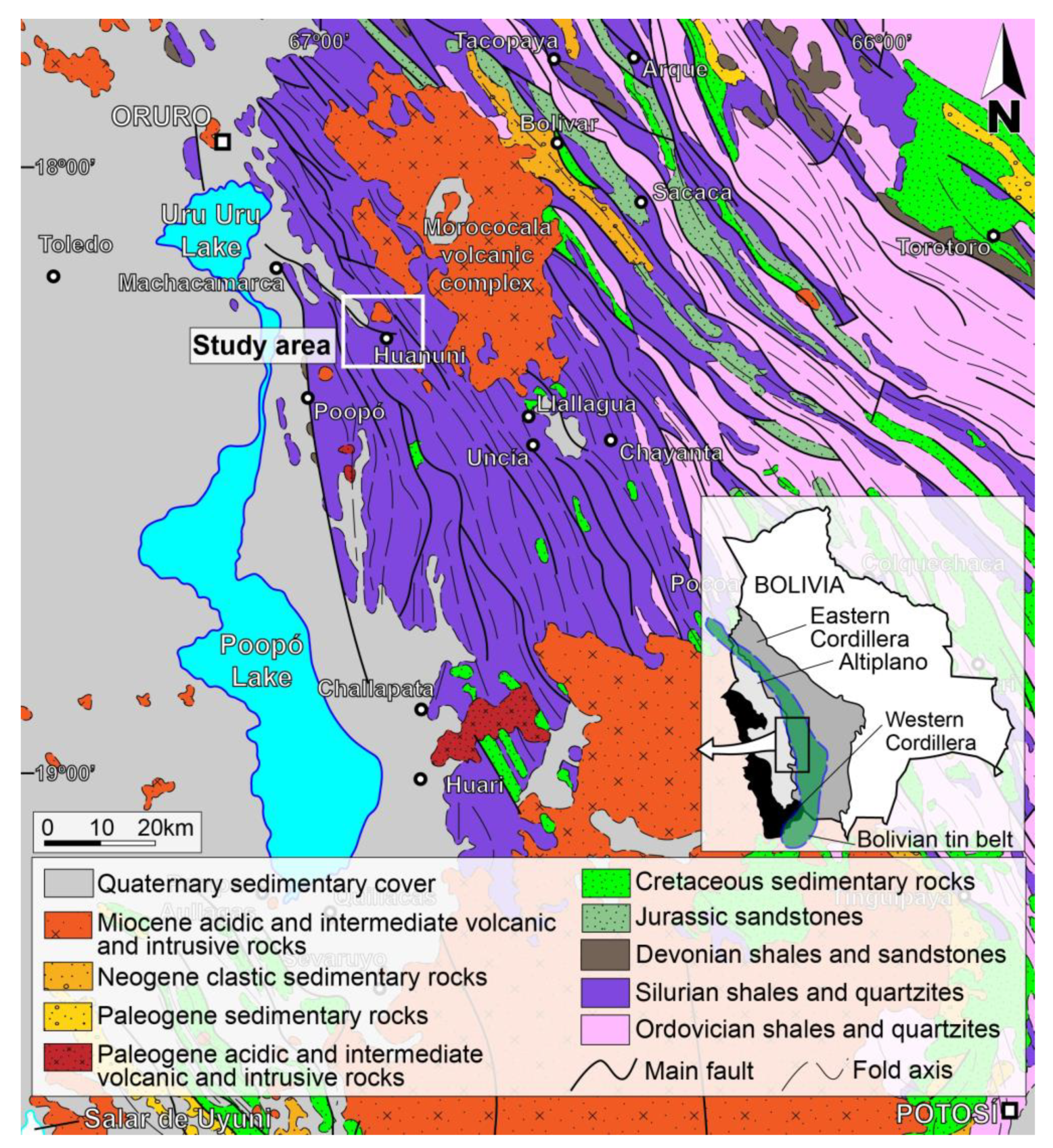
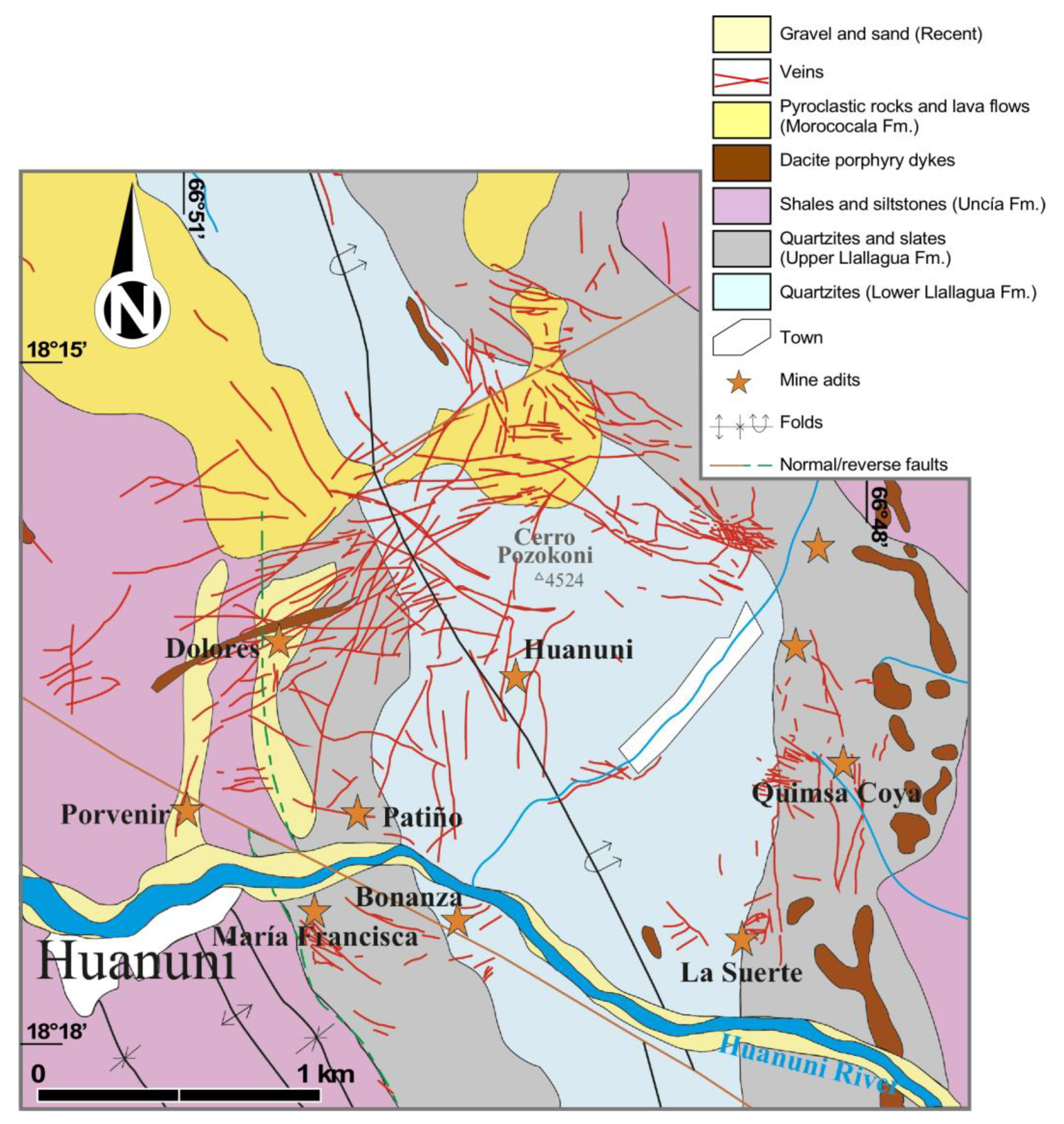
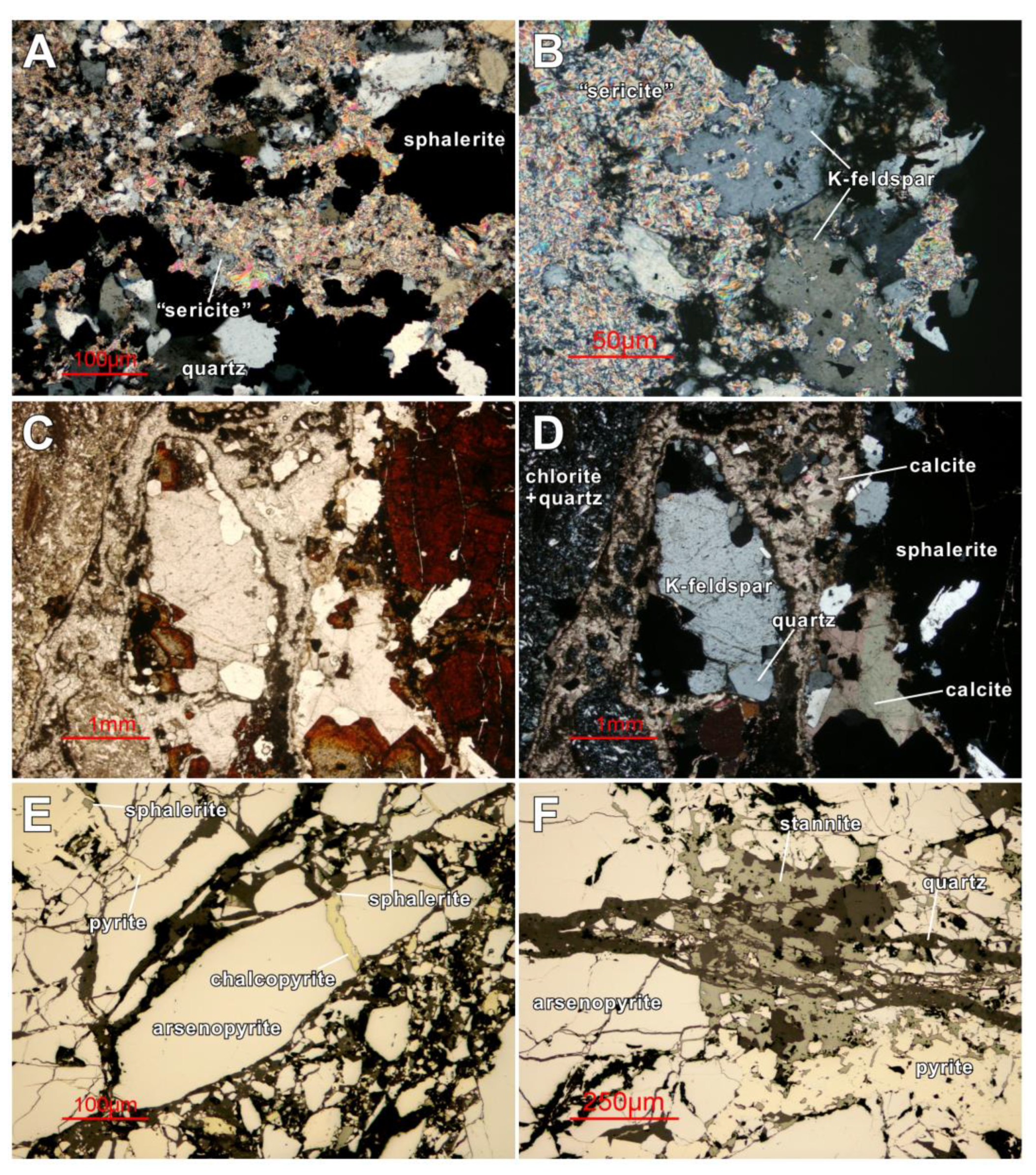
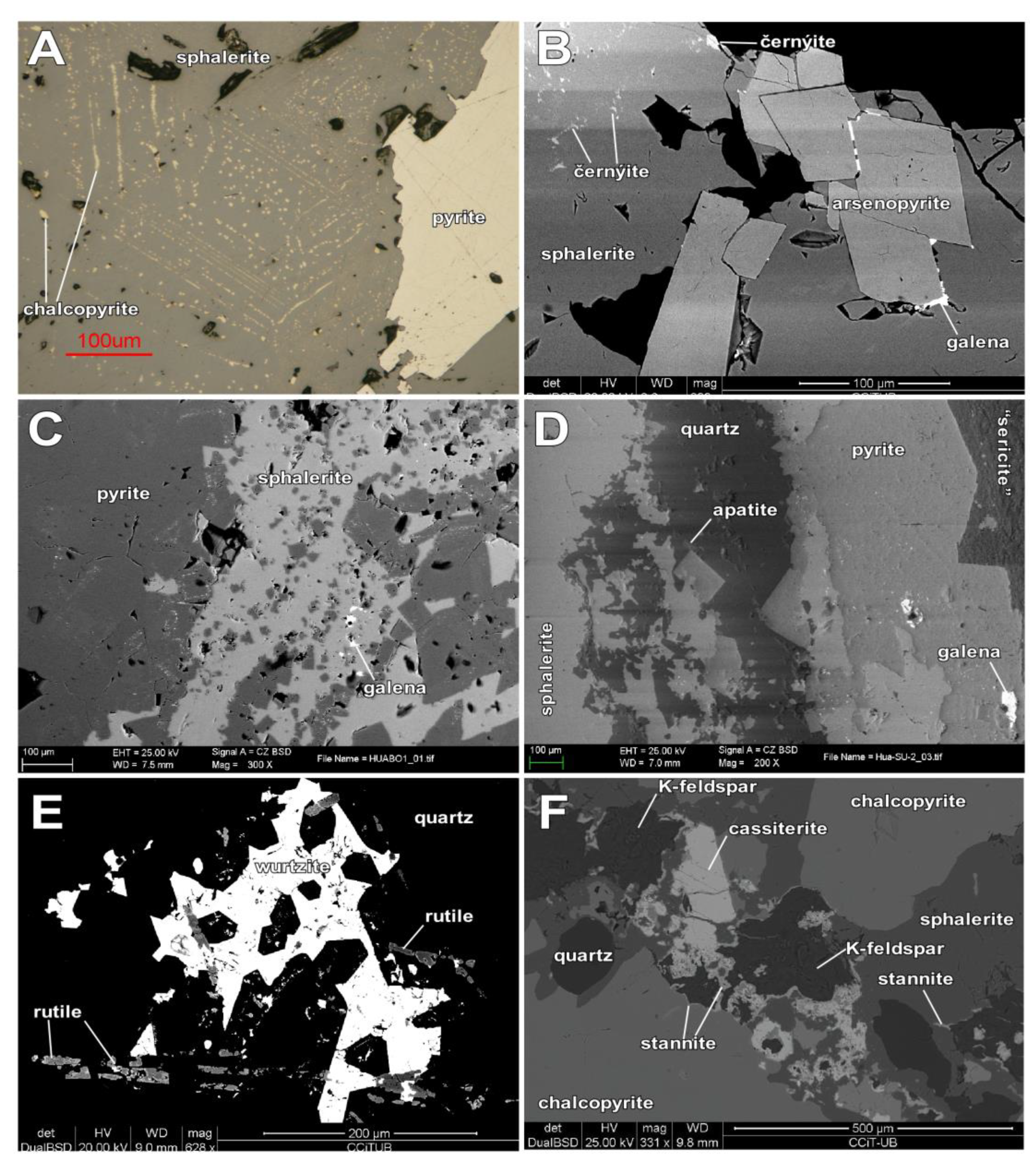
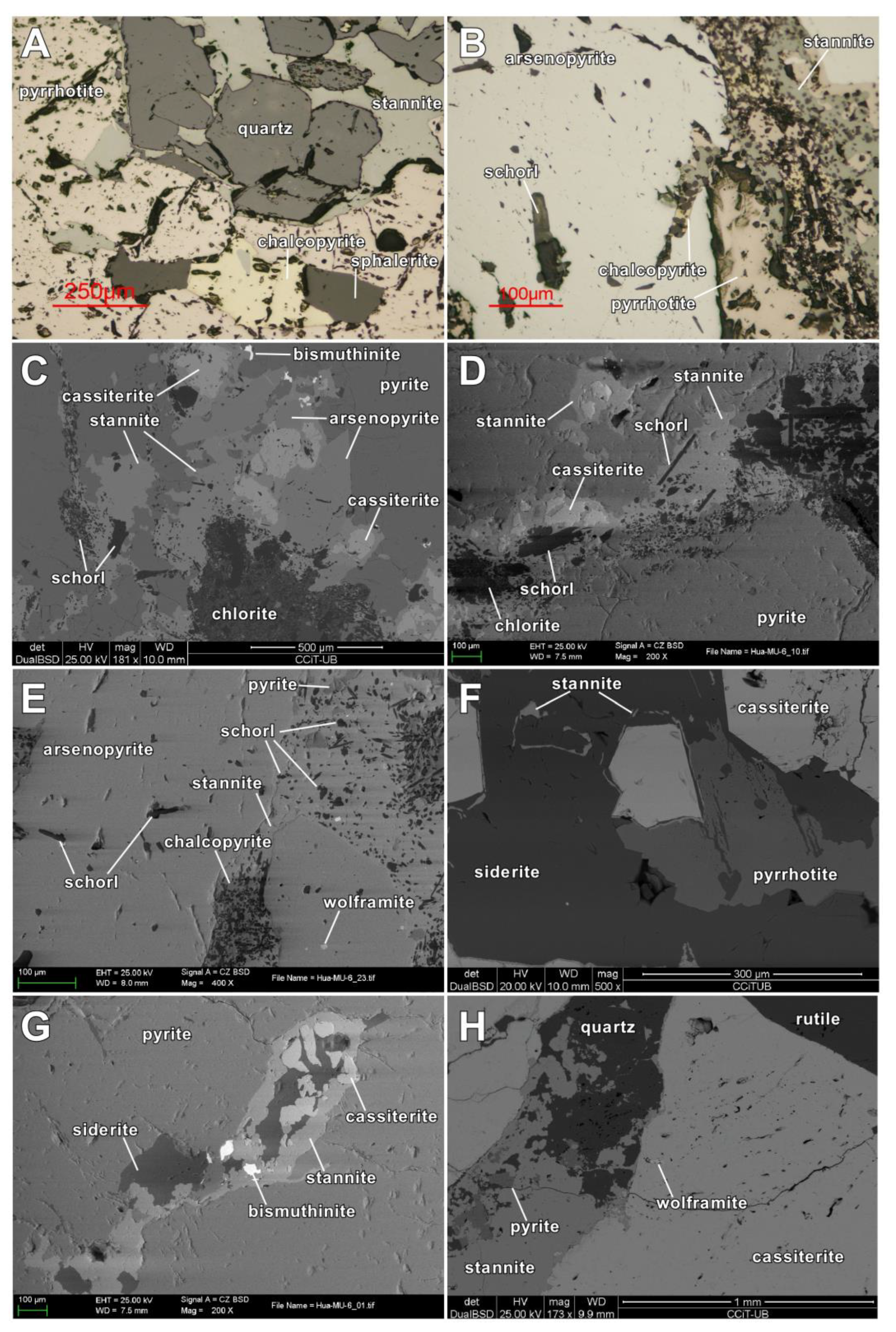
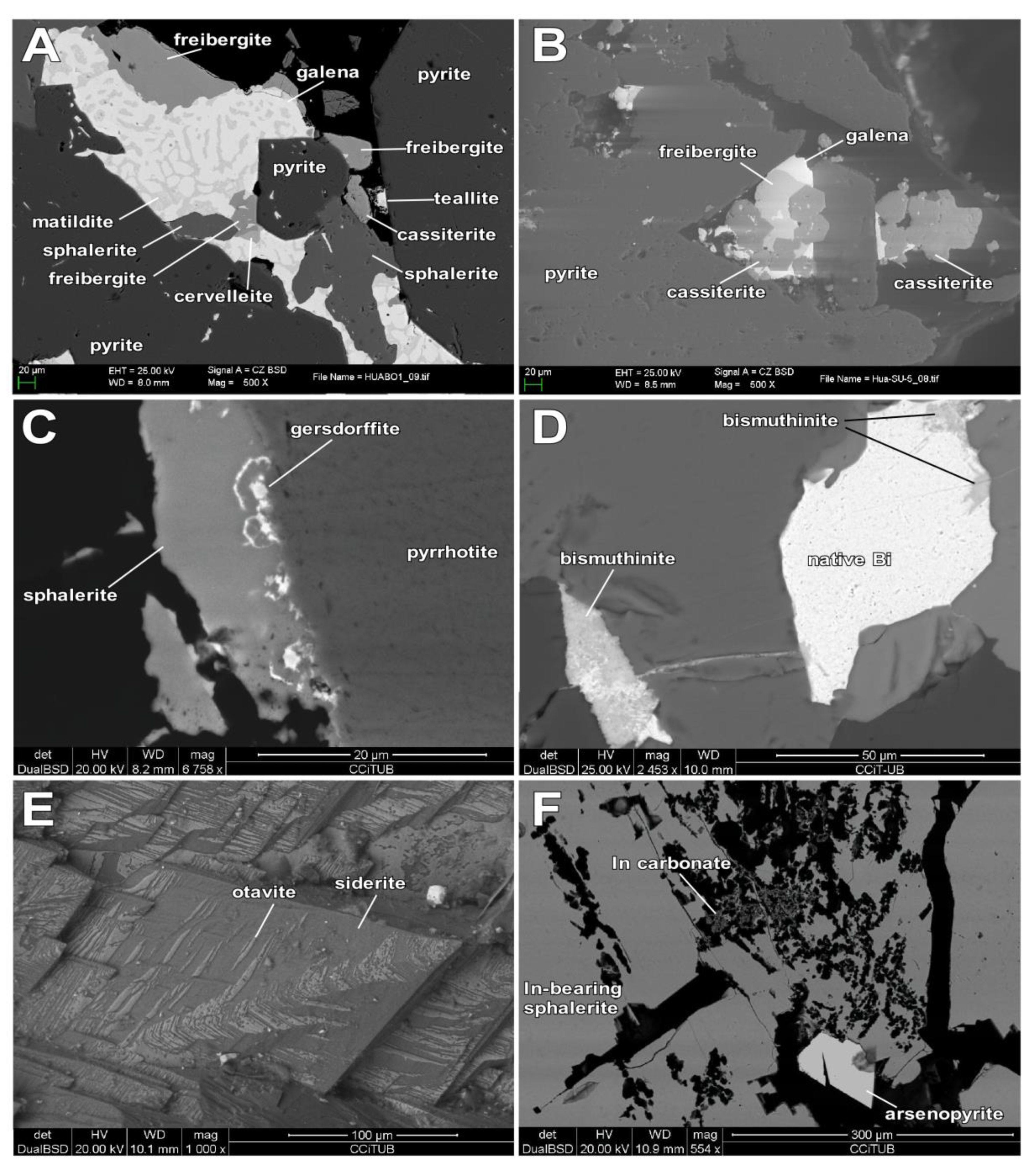
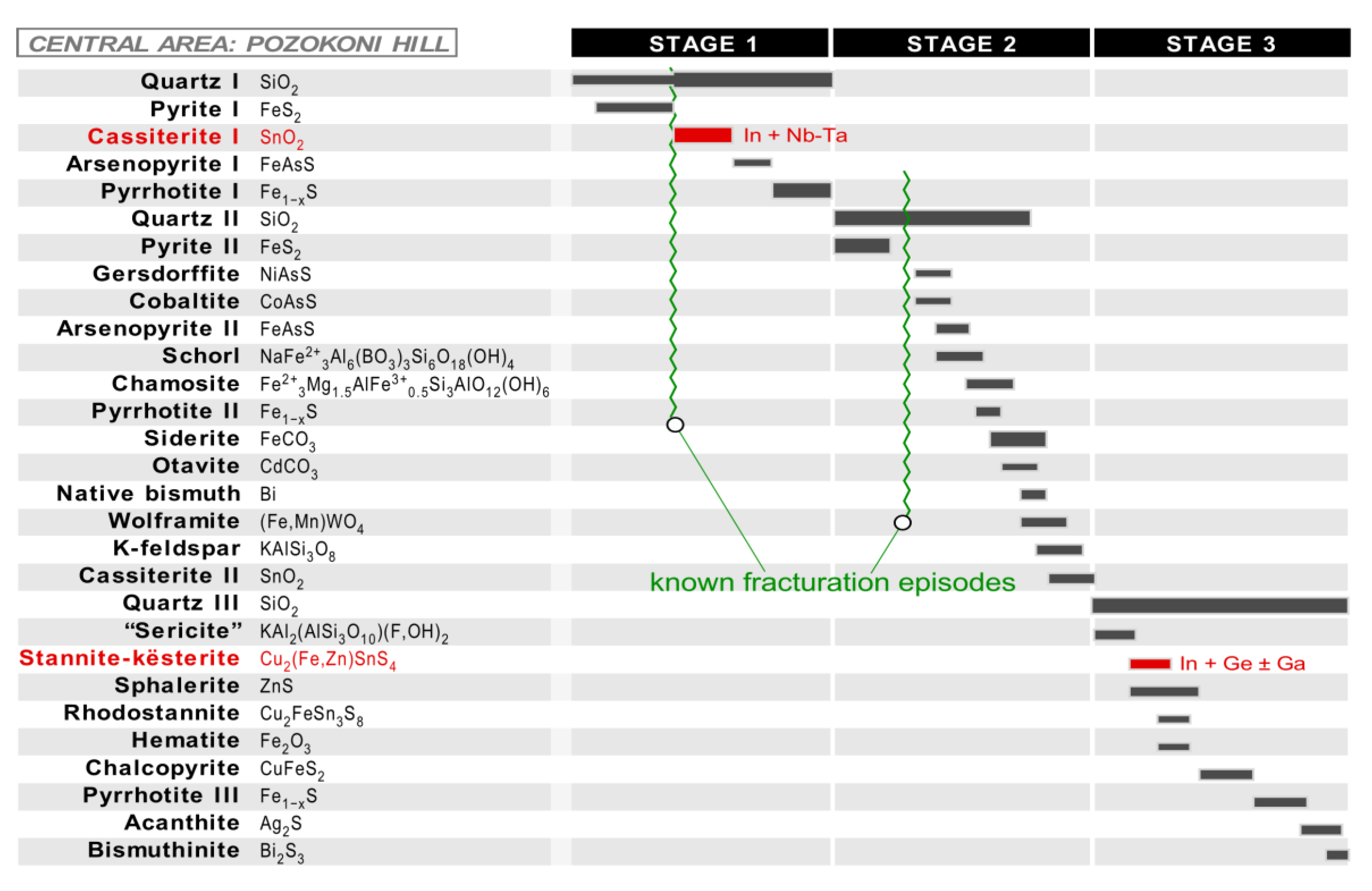
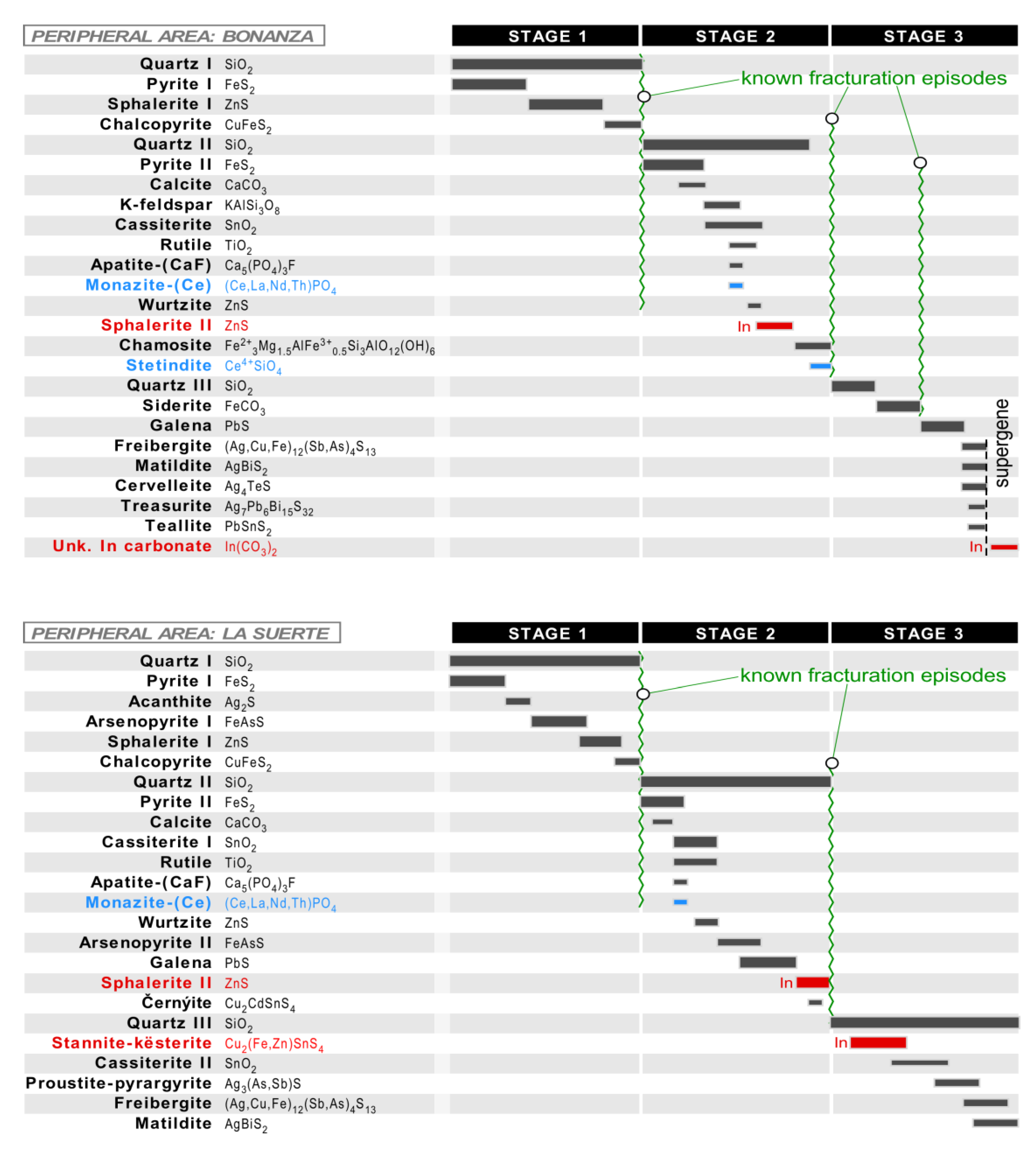
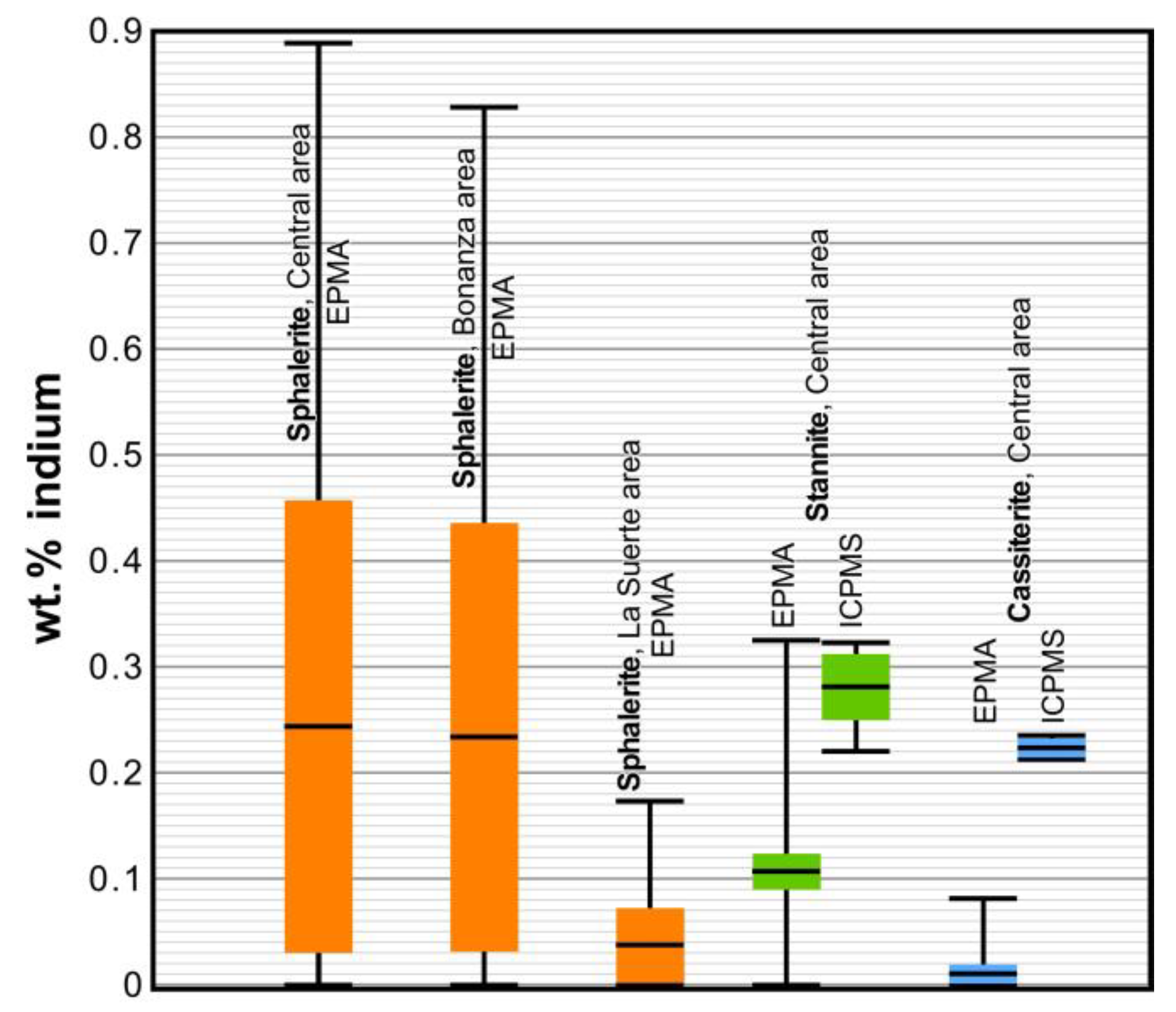

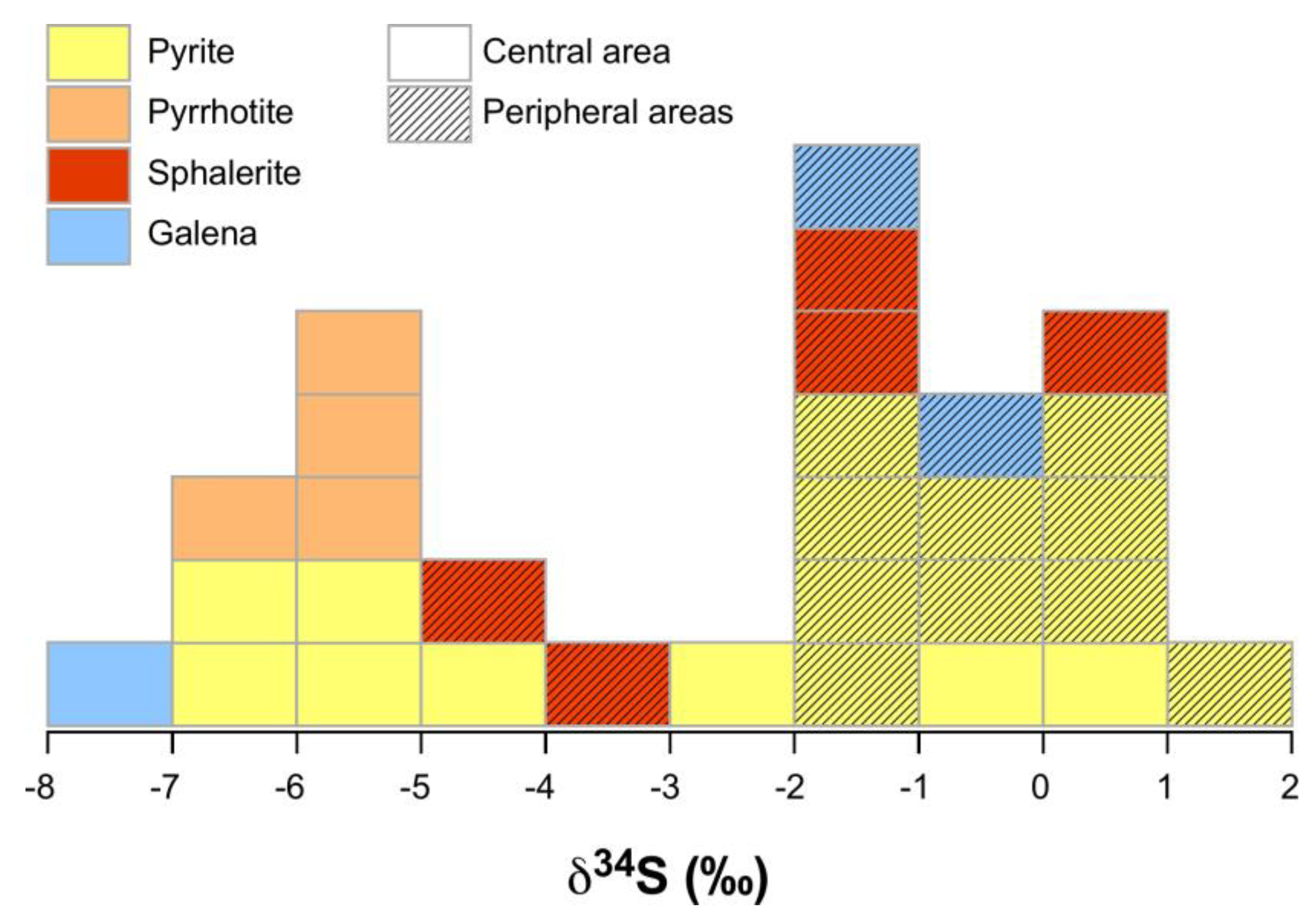
| Mineral | Area | Element | Type of Value | wt.% | n | Method |
|---|---|---|---|---|---|---|
| sphalerite | Central | Fe | Average | 9.50 | 23 | EPMA |
| Std.dev. | 5.43 | |||||
| Maximum | 21.80 | |||||
| Minimum | 0.27 | |||||
| In | Average | 0.24 | 23 | EPMA | ||
| Std.dev. | 0.21 | |||||
| Maximum | 0.88 | |||||
| Minimum | b.d.l. | |||||
| Bonanza | Fe | Average | 6.62 | 11 | EPMA | |
| Std.dev. | 4.04 | |||||
| Maximum | 11.00 | |||||
| Minimum | 0.48 | |||||
| In | Average | 0.20 | 11 | EPMA | ||
| Std.dev. | 0.23 | |||||
| Maximum | 0.82 | |||||
| Minimum | b.d.l. | |||||
| La Suerte | Fe | Average | 9.26 | 19 | EPMA | |
| Std.dev. | 2.67 | |||||
| Maximum | 11.97 | |||||
| Minimum | 2.86 | |||||
| In | Average | 0.02 | 19 | EPMA | ||
| Std.dev. | 0.05 | |||||
| Maximum | 0.17 | |||||
| Minimum | b.d.l. | |||||
| All areas | Fe | Average | 8.82 | 53 | EPMA | |
| Std.dev. | 4.40 | |||||
| Maximum | 21.80 | |||||
| Minimum | 0.27 | |||||
| In | Average | 0.15 | 53 | EPMA | ||
| Std.dev. | 0.20 | |||||
| Maximum | 0.88 | |||||
| Minimum | b.d.l. | |||||
| stannite | Central | In | Average | 0.12 | 19 | EPMA |
| Std.dev. | 0.09 | |||||
| Maximum | 0.32 | |||||
| Minimum | b.d.l. | |||||
| In | Average | 0.28 | 7 | LAICPMS | ||
| Std.dev. | 0.03 | |||||
| Maximum | 0.33 | |||||
| Minimum | 0.23 | |||||
| Ge | Average | - | 19 | EPMA | ||
| Std.dev. | - | |||||
| Maximum | 0.13 | |||||
| Minimum | b.d.l. | |||||
| Ga | Average | 63 ppm | 7 | LAICPMS | ||
| Std.dev. | 40 ppm | |||||
| Maximum | 123 ppm | |||||
| Minimum | 8 ppm | |||||
| cassiterite | Central | In2O3 | Average | 0.01 | 50 | EPMA |
| Std.dev. | 0.01 | |||||
| Maximum | 0.08 | |||||
| Minimum | b.d.l. | |||||
| In | Average | 0.22 | 3 | LAICPMS | ||
| Std.dev. | 0.01 | |||||
| Maximum | 0.22 | |||||
| Minimum | 0.21 | |||||
| Nb2O5 | Average | 0.04 | 50 | EPMA | ||
| Std.dev. | 0.06 | |||||
| Maximum | 0.21 | |||||
| Minimum | b.d.l. | |||||
| Ta2O5 | Average | 0.05 | 50 | EPMA | ||
| Std.dev. | 0.08 | |||||
| Maximum | 0.37 | |||||
| Minimum | b.d.l. |
| Area | Mine | Sample | Mineral | δ34SVCDT (‰) |
|---|---|---|---|---|
| Central | Huanuni | HUA-240 | galena | −7.5 |
| pyrite | −2.0 | |||
| HUA-240-1 | pyrrhotite | −5.8 | ||
| HUA-240-2 | pyrrhotite | −5.9 | ||
| HUA-MU-2 | pyrite | 0.2 | ||
| pyrrhotite | −5.3 | |||
| HUA-MU-3 | pyrite | −6.3 | ||
| HUA-MU-4 | pyrite | −4.5 | ||
| HUA-MU-5 | pyrite | −5.3 | ||
| HUA-MU-6 | pyrite | −5.9 | ||
| pyrite | −6.1 | |||
| HUA-MU-7 | pyrite | −0.1 | ||
| HUA-MU-8 | pyrrhotite | −6.2 | ||
| Peripheral | Bonanza | HUA-BO-1 | pyrite | −0.8 |
| HUA-BO-2 | pyrite | 0.5 | ||
| HUA-BO-3 | sphalerite | −1.1 | ||
| HUA-BO-4 | pyrite | −1.3 | ||
| La Suerte | HUA-SU-1 | sphalerite | −4.2 | |
| sphalerite | −1.7 | |||
| HUA-SU-2 | pyrite | −0.9 | ||
| sphalerite | 0.2 | |||
| HUA-SU-3 | pyrite | −1.8 | ||
| pyrite | 1.0 | |||
| sphalerite | −1.0 | |||
| galena | −0.2 | |||
| HUA-SU-4 | pyrite | −1.3 | ||
| galena | −1.7 | |||
| HUA-SU-5 | pyrite | 0.8 | ||
| HUA-SU-6 | pyrite | 0.5 | ||
| sphalerite | −3.3 |
© 2019 by the authors. Licensee MDPI, Basel, Switzerland. This article is an open access article distributed under the terms and conditions of the Creative Commons Attribution (CC BY) license (http://creativecommons.org/licenses/by/4.0/).
Share and Cite
Cacho, A.; Melgarejo, J.-C.; Camprubí, A.; Torró, L.; Castillo-Oliver, M.; Torres, B.; Artiaga, D.; Tauler, E.; Martínez, Á.; Campeny, M.; et al. Mineralogy and Distribution of Critical Elements in the Sn–W–Pb–Ag–Zn Huanuni Deposit, Bolivia. Minerals 2019, 9, 753. https://doi.org/10.3390/min9120753
Cacho A, Melgarejo J-C, Camprubí A, Torró L, Castillo-Oliver M, Torres B, Artiaga D, Tauler E, Martínez Á, Campeny M, et al. Mineralogy and Distribution of Critical Elements in the Sn–W–Pb–Ag–Zn Huanuni Deposit, Bolivia. Minerals. 2019; 9(12):753. https://doi.org/10.3390/min9120753
Chicago/Turabian StyleCacho, Andreu, Joan-Carles Melgarejo, Antoni Camprubí, Lisard Torró, Montgarri Castillo-Oliver, Belén Torres, David Artiaga, Esperança Tauler, Álvaro Martínez, Marc Campeny, and et al. 2019. "Mineralogy and Distribution of Critical Elements in the Sn–W–Pb–Ag–Zn Huanuni Deposit, Bolivia" Minerals 9, no. 12: 753. https://doi.org/10.3390/min9120753
APA StyleCacho, A., Melgarejo, J.-C., Camprubí, A., Torró, L., Castillo-Oliver, M., Torres, B., Artiaga, D., Tauler, E., Martínez, Á., Campeny, M., Alfonso, P., & Arce-Burgoa, O. R. (2019). Mineralogy and Distribution of Critical Elements in the Sn–W–Pb–Ag–Zn Huanuni Deposit, Bolivia. Minerals, 9(12), 753. https://doi.org/10.3390/min9120753







